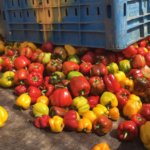A volunteer story: ‘Fasayel, where the resistance is made by mud bricks and straw’
Published at 7th September of 2011 by Electroneslibres
Fasayel at 9 August of 2011.- We are waiting for the time to make “tina”, a mixture of mud and straw from which we making mud bricks to build a house in this tiny village in the Jordan Valley. We are sat together in a small house provided for the internationals to stay.
It is really hot, so we start working at 5-6 p.m., when the sun is not so punishing. While I am writing another Jordan Valley Solidarity activist is playing the guitar and, thanks to that, the minutes disappear. He has a beautiful voice and a great will. He is the first one of us hitting the hard crust of this land to make dust which we mix with water. We are using the white land in this desert that has given so much history.
The history of this Palestinian village is hard, but you can forget it with so many smiles and banter of the children, the kindness of our hosts, the kindness of their folk. Actually we are doing something without permission against the Israeli policy. Making mud bricks during the night is reason for detention in this part of the planet.
The Jordan Valley is an Israeli military exclusion area almost in its totality, so building any kind of thing without their permit is like going against their law. In fact, the ethnic cleansing ongoing in such a systematic way is horrifying; from more than 300.000 people that were living here before 1967, remain now only 52.000. The demolition of the houses in these villages is an expulsion being carried out in practice for many years and this village is not a exception at all. To rebuild them is a crime, so we are criminals with nocturnally and treachery. This is accompanied by the construction of settlements that take over huge extensions of land for cultivation fed by the Jordan River water, water which is forbidden to the Palestinians and Bedouins of the area. Another strategy carrying out by the occupation forces is the destruction of Palestinian wells that use the abundant underground aquifers in the area. The water is rationed for these populations, which are supplied with water tanks or with water at certain times of the day.
Fasayel is a village with small barracks. Many of its inhabitants own sheep, so the children are born as shepherds. The average source of income in these Palestinian villages is the work in the illegal settlements, for which they got paid around 60 NIS (New Israeli Shekels) per day. Child labour is usual too. Children from 10 to 14 years old work in the settlements for a salary of 50 NIS a day.
The closest settlement to Fasayel is Tomer. The settlements here, in the Jordan Valley, are big extensive exploitations of agricultural products, mainly focused on the exportation, with labelling factories and packing aside. Tomer is specialized, so far we know, on dates. Huge date palm extensions cover the horizontal line preventing us from seeing the Jordan River. The road 90, going from Jericho to Jerusalem separates the illegal settlement from Fasayel village, completely dry. A village where rocks and the white land refers us to a lunar landscape. The contrast between this Palestinian village and the greenery of the settlement is simply spectacular.
The facts we have about the situation in the Jordan Valley are that occupation polities are being implemented in a spectacular manner since second Intifada. These polities consisting on the displacement and demolition of villages with the intention of isolating from the rest of the West Bank, through the progressive unilateral annexation while the international attention is focused on the internal Palestinian fight or on the attacks to Gaza Strip. Israel encourages its young men and women to convert in settlers with future development agricultural or tourism projects. Important economical benefits also are implemented to encourage the illegal displacement of the Israeli population.
We have to remember that according to the Geneva Convention, it is illegal that any Occupying Estate displaces some of its population into the occupied territory. These polities of encouragement include free education and health, the 75% of discount in all the water, electricity, communication and transport invoices, as well as automatic concession of land to each family (around 70 dunums, 1 dunum = 1000 m2), long term credits for starting the life project there (around 20.000 dollars), free irrigation water and much more that, even for me that suffer from the precariousness in Spain, it would be attractive to me to move into the Israeli citizenship
Many of the settlers evicted from Gaza in 2005 have been reaccommodated in the settlements of the Jordan Valley, as is the case of the Maskiyot settlement, which in 1982 was a military base and since 2002 became a settlement for Jews students. 20 families were installed there in prefabricated houses, until 2006, after a house construction plan started which was temporally freeze due to the international pressure, although in 2009 they started been constructed until today.
To get an idea, in 1968 there were 3 settlements, in the north Mehola, in the center Argaman and in the south Kalia, in the confiscated land to Palestinian villages. Between 1970 and 1980 the number increased to 11 settlements and since 1990 is has increased until 39.
The importance of the area is based on its water resources and, on the other side, as a security area for any possible Arab invasion. For that reason the Israeli side of the Jordan Valley is fenced with electrical fence.
In this situation, in which Palestinians are slowly strangled in daily by the army and the Israeli ethnic cleansing polities, the resistance takes the shape of a mud brick and straw.


